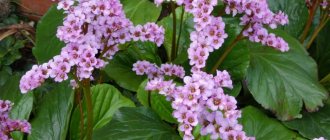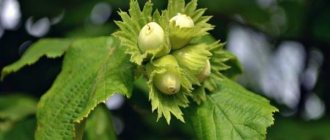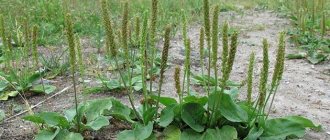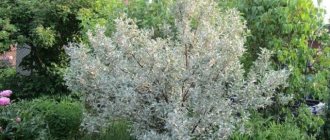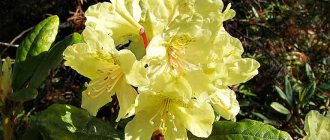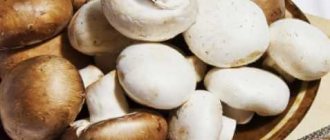Description and photo of the plant
Bergenia is a wild and cultivated plant, also called thick-leaved saxifrage. In the wild, it is found mainly in China, Mongolia and Kazakhstan; in Russia it grows in the Krasnoyarsk Territory, Yakutia and Primorye.
It is quite easy to recognize the plant. It reaches a height of about half a meter, while the rounded leaves can be up to 30 cm in length and more than 20 cm in width. Bergenia blooms with beautiful small flowers of white, pink or purple, collected in inflorescences.
How to prepare and store raw materials
Rhizomes and leaves are harvested separately.
Roots
When the bergenia fades, you can dig up the rhizome. This should begin at the end of June. The roots are washed, finely chopped, and then dried outside or in a dryer (temperature does not exceed 30°C). Drying lasts about a month. Store the roots in a container with a tightly closed lid. Properties can be maintained for 3 years.
Leaves
The leaves are dried on a thin layer of paper or wood. The required temperature is 30°C. The resulting material is stored in a paper bag or glass jar. It is necessary to limit access to moisture. Storage reaches 3 years.
Types and varieties of bergenia
On the territory of Russia, in cultivated form, you can find mainly two types of bergenia - Thick-leaved and Heart-leaved. In addition to them, there is Strecha, Pacific, Schmidt, Himalayan and others.
Gardeners often plant specially bred varieties of bergenia with late and long flowering periods. For example:
- Overture;
- Beethoven;
- Andrea;
- Pink Dragonfly.
The listed varieties bloom in late spring, and some bergenias are able to bloom a second time at the end of summer.
Chemical composition of bergenia roots and leaves
The beneficial properties of bergenia herb are contained both in the leaves and in the root system of the plant. In particular, the value of bergenia roots is provided by:
- glucose;
- ascorbic acid;
- polyphenols;
- starch;
- tannins;
- antioxidant arbutin;
- natural sugars.
The leaves of the plant also contain arbutin, which has antioxidant properties, and tannins. In addition to them, the composition includes:
- the most valuable minerals for the body are copper, iron and manganese;
- carotene and vitamin C;
- gallic acid;
- coumarins;
- resins;
- essential oils;
- flavonoids.
Chemical composition
The rhizome of the plant is considered the most useful part, as it contains arbutin. The root system also contains many:
- Glucose;
- Starch;
- Arsorbic acid;
- Polyphenols;
- Sugar;
- Bergenin isocoumarin.
The roots contain about 27% tannins.
The foliage contains about 35% pyrocatechol and pyrogallic tannins. Also in bergenia foliage there is a high content of:
- Carotene;
- Copper;
- Vitamin C;
- Gland;
- Flavonoids;
- Gallic acid;
- Manganese;
- Tannins;
- Kumarinov.
In addition, the plant contains essential oils and resins.
Healing properties and uses of bergenia leaves
The leaves of the plant are most often used to fight inflammation and infections and to stop bleeding. Decoctions and infusions from the leaves help with:
- headaches;
- rheumatism;
- pneumonia and tuberculosis;
- diarrhea and stomach and intestinal ailments;
- sore throat;
- hypertension;
- kidney ailments.
The beneficial properties of bergenia for women are especially worth noting - the plant removes inflammation and stops uterine bleeding, helps cure cervical erosion.
Bergenia: medicinal properties and uses
The plant is given honorable first place as the plant with the highest content of tannins. For example, in this matter, bergenia is “four times stronger” than oak! The richest raw materials in tanning agents are those collected in the highlands. Bergenia is used in industry for tanning leather and soles, impregnating fishing nets and tarpaulins, and producing dyes.
The rhizomes are used for food, which are pre-soaked in water, and a healing drink, Chigir tea, is prepared from the leaves. Both bergenia rhizomes and leaves are used for medicinal purposes. Aqueous extract of bergenia is used as a remedy for:
- colitis;
- tuberculosis;
- pneumonia;
- pulmonary hemorrhages;
- acute respiratory infections;
- laryngitis;
- migraines;
- fever;
- rheumatism of joints;
- gastrointestinal diseases;
- gynecological problems;
- diseases of the oral cavity;
- dysentery;
- hemorrhoids.
Poorly healing wounds, bruises and ulcers are treated with compresses from the infusion of rhizomes and leaves of the plant.
Traditional medicine recipes with bergenia
In order for the properties of bergenia to be beneficial and not harmful, you need to know how and for what ailments the plant is used.
Decoction
The rhizomes of the medicinal plant are most often boiled in clean water. In order to prepare a useful remedy, you only need to spend half an hour.
- Finely chopped or powdered roots in the amount of 2 large spoons are poured into 0.5 liters of water, and then cooked over low heat for no more than 30 minutes under the lid.
- The finished product is filtered and cooled at room temperature.
Drink the product diluted to avoid harm from excessive concentration, three times a day, before meals, in an amount of no more than 2 large spoons.
A decoction based on the root is good for hemorrhoids and gynecological ailments, gastritis and ulcers. It will be beneficial for colds, inflammatory diseases, and coughs.
Infusion
Chopped roots and leaves can simply be poured with boiling water (1 cup per 1 large spoon of raw materials) and kept covered for 2 hours. Drink a healthy infusion 3-4 times a day, no more than 2 large spoons at a time.
The properties of the infusion bring the greatest benefit to sore throats and bleeding gums. The infusion can be used to wipe wounds and abrasions on the skin; the product is used in the treatment of dermatological diseases.
Alcohol tincture
For colds, joint and respiratory diseases, the healing alcohol-based drink from bergenia is especially beneficial.
- Finely chopped plant root in the amount of 40 g is poured with 100 g of vodka or alcohol.
- Close the glass vessel tightly and place it in a dark place for 10 days.
- After this period, filter the tincture and drink three times a day, adding 30 drops of the product to a glass of clean water.
Alcohol tincture is especially useful in the treatment of ARVI and influenza, bronchitis and pneumonia. It is also used for rubbing sore joints and for warming compresses.
Bergenia extract
A couple of large spoons of dry crushed root or leaves are poured into 200 ml of boiling water and simmered over low heat under a lid until the water has boiled by half. Then the extract is filtered and taken 30 drops three times a day for pancreatitis, inflammation and to strengthen the immune system.
Boiled bergenia root is beneficial for diarrhea. The product also helps against stomatitis - dilute 20 ml of the product with a glass of water and rinse your mouth several times a day.
Bergenia root powder
You can grind bergenia root into powder and use it to quickly heal wounds and other skin damage. The application scheme is very simple - wounds, ulcers and healing burns are simply sprinkled with powder, leaving it for several hours.
You can also make compresses from the powder. In this case, the instructions for bergenia root look as simple as possible - it is diluted with water to a thick mass, pressed to the sore spot with gauze or a cotton pad and secured with a bandage.
Traditional medicine recipes
Based on bergenia the following is prepared:
- Infusions;
- Decoctions;
- Aqueous extracts,
which contain vitamins and essential microelements.
The rhizome is often used for medicinal purposes, but the leaves also have healing properties.
You can prepare not only a medicinal drink, but also brew aromatic tea, which perfectly tones and strengthens the body. The leaves contain vitamin C, which helps strengthen the immune system and is effective in eliminating the symptoms of viral diseases.
Strengthening tea
The most common use is tea. In addition to its therapeutic effect, tea and infusion from the leaves quenches thirst well. In Siberia, this tea is called Mongolian or Chigir tea. The drink tones and improves metabolism. Helps:
- Get rid of headaches;
- Reduces blood pressure;
- Restores heart rhythm;
- Strengthens the walls of capillary vessels;
- Has a positive effect on potency.
To prepare the drink, brew several dried leaves with 2-3 cups of boiling water. After steeping, strain and add honey.
Grind the leaves. Place 2 tablespoons in a thermos and brew with 1 liter of boiling water. Leave for 30 minutes. Drink as tea, adding honey or other sweetener.
Decoction of leaves
A decoction of the leaves has astringent and hemostatic properties and is effective for healing skin lesions.
Chopped leaves, 2 tablespoons, pour 1 glass of boiling water into a thermos. Leave for 4 hours. Then strain. It is recommended to drink two tablespoons three times a day after meals.
Rhizome decoction
To prepare the decoction, pour a tablespoon of chopped rhizome into 1 glass of hot water. Boil over low heat for half an hour, covering with a lid. After straining, add boiled water to the original volume.
For chronic stomatitis
A decoction is prepared from 2 teaspoons of rhizome and a glass of water. Rinse your mouth three times a day.
This decoction can be used for douching for female inflammatory diseases.
Externally in the form of compresses - to accelerate the healing of wounds, ulcers, bruises.
Aqueous extract
You need to take 3 tablespoons of dried crushed root. Pour 200 ml of boiling water. Boil over low heat until the volume of liquid is reduced by half. Strain.
Take 20-30 drops three times a day for 2-3 weeks for:
- Women's inflammatory diseases;
- Bleeding.
Diluted in a ratio of 1:10, it is used in the form of douching for cervical erosion and colitis.
Treatment of seborrhea
Dilute the aqueous extract with boiled water in a ratio of 1 part extract to 10 parts water. Rinse your hair after washing 2 times a week.
For diseases of the digestive tract
Grind the leaves. Place 2 tablespoons in a thermos and pour 1 liter of boiling water. Leave for about 10 hours, strain. It is recommended to take the infusion three times a day, a quarter glass, 30 minutes before meals.
For cystitis
Use a decoction of rhizomes and leaves. Brew 2 tablespoons of herbs with 1 glass of hot water. Boil over low heat for 30 minutes. Drink 50 ml 3 times a day for at least 5 days.
The benefits and harms of bergenia tea
The leaves of the plant can be used to treat diseases, but often they are used simply for brewing tasty and healthy teas. The benefits of bergenia tea are that the drink:
- saturates the body with vitamins and microelements;
- strengthens the immune system and prevents colds;
- improves intestinal function;
- It has a slight tonic effect and is very relaxing.
However, tea made from the leaves of the plant can be harmful. In too large quantities, the drink causes constipation, lowers blood pressure, and can cause tachycardia. You should not drink it if you have allergies or high blood density; tea is not recommended for young children under 5 years of age and pregnant women.
We recommend reading: Mint tea: beneficial properties and contraindications, how to make
What is bergenia tea and its chemical composition
Bergenia is an ancient plant that has been consumed for several centuries. In Mongolia, it was from it that a drink was infused to restore strength after long hikes. And all because bergenia contains a set of useful vitamins, essential oils and microelements.
We advise you to read: Gaba Alishan tea: benefits and harm
The rhizomes of the plant retain a high concentration of vitamin C, essential oil and glycosides, as in tea with viburnum, lemon and hibiscus. The leaves are rich in active microelements such as copper, manganese and iron. All beneficial substances are retained after harvesting. So bergenia tea retains all the elements mentioned above in its composition.
Beneficial properties of bergenia tea
Tea made from bergenia root is considered especially beneficial. The drink promotes vasoconstriction, so if you have problems with cardiovascular diseases, it’s definitely worth drinking. Tea from rhizomes is recommended if it is necessary to fight viruses. Helps with:
- diseases of the lungs and bronchi;
- ulcers and gastritis;
- heavy menstruation.
Tea made from bergenia leaves is less beneficial. However, it also has antibacterial properties and is used if a person has diseases of the intestines and stomach, inflammation of the diuretic system. Has a positive effect on the skin, eliminates acne. Chigir tea also quenches thirst well.
How to brew bergenia tea correctly
The algorithm for brewing healing tea is almost no different from the usual scheme.
- A large spoonful of dried leaves is poured into a teapot, previously scalded.
- The raw materials are poured with 300 - 500 ml of boiling water.
- Leave for about 20 minutes, then pour the tea leaves into a cup, dilute with water and drink.
There is only one subtlety here - in order for the tea to brew properly, you need to brew it a little longer than usual.
We recommend reading: Tea with thyme: beneficial properties and contraindications
Indications and contraindications for using bergenia for women
The use of bergenia for women can have a beneficial effect on a woman’s body, namely:
- relieve stress;
- stabilize blood pressure;
- improve the functioning of the digestive system;
- relieve bleeding, including heavy menstrual flow;
- improve the health of the female reproductive system.
For the fair sex, it is very important that the reproductive organs are painless and do not cause discomfort. Her psycho-emotional state, and therefore her joyful mood, depends on this. Therefore, it is very important to know not only about the medicinal properties of bergenia for women, but also contraindications for use. These include:
- high blood clotting;
- individual intolerance;
- hypotension;
- tendency to allergies.
Important! The plant is a fairly strong natural medicine. Therefore, in the presence of chronic diseases, during pregnancy and lactation, consultation with a qualified specialist is required before use.
Recipes for making tea from bergenia (Chigir tea)
A drink made from medicinal saxifrage leaves can be brewed in different ways. Some people prefer the classic recipe, while others add other ingredients that improve the taste and beneficial properties of Chigir tea.
Classic recipe
The usual procedure involves using only dry bergenia leaves. They are poured into a teapot and poured with boiling water, then wait 20 minutes, filter, dilute and drink.
Advice! If desired, you can not only infuse the tea, but also boil it, bringing it to a boil over a fire, and then leaving it to stand for the same 20 minutes. This tea will have a more pronounced taste.
Tea with lingonberries and bergenia
Lingonberry is a vitamin plant that is often used for diabetes, sand in the kidneys, cystitis and other diseases. The leaves can be added to incense tea, enhancing its healing effect.
- 3 teaspoons of bergenia are poured into a small saucepan, a teaspoon of chopped lingonberry leaves and oregano are added to it.
- The raw material is poured into a glass of clean water and the tea is allowed to boil.
- The finished drink is infused for an hour and a half under the lid, and then filtered.
It is recommended to drink a small cup of Chigir tea with lingonberries twice a day; if desired, you can add sugar or honey to it. However, with gastritis and ulcers, it is better to abstain from the drink to avoid harm.
Bergenia leaf tea with blueberries
Blueberry Chigir tea is especially useful for colds and coughs. It's easy to prepare - just add water to a dry mixture of bergenia leaves, blueberry leaves and drupe leaves. You can also add thyme.
The mixture is boiled, then turned off and left covered for 2 hours. You can drink this tea up to 3 times a day.
Tea with bergenia and cloudberries
Cloudberry is a plant whose leaves have an antiseptic effect. Drinking Chigir tea with cloudberries is useful for colds, kidney stones and cystitis; the drink is also very calming.
To prepare it, mix 3 teaspoons of bergenia with 1 spoon of dried cloudberry leaves, add a little thyme and mantle leaves. The tea is boiled and left closed for the standard time - about 20 minutes.
The finished drink is consumed in a cup no more than three times a day; for taste and benefit, honey or sugar, raspberries or rose hips are additionally added to it.
Tea with bergenia and strawberries
Vitamin-rich strawberries bring great benefits to the skin; the leaves of the plant eliminate constipation and cleanse the blood, and help with coughs. Prepare tea as follows:
- dry strawberry leaves in the amount of 3 teaspoons are mixed with 4 spoons of bergenia, add dried black currant leaves and crushed wheatgrass root (a teaspoon each);
- the mixture is poured with water and boiled over medium heat, and then left for about an hour.
Drink a healthy drink as desired and as needed, no more than three times a day, in small cups.
Recipes with bergenia root and instructions for use
There are different ways to prepare medicines from bergenia plant materials. They are easy to do yourself at home. You don't need to buy expensive ingredients for this. Below you can learn more about the basic recipes.
Decoction
Method for preparing the decoction:
- One tablespoon of chopped rhizome is poured with a glass of boiling water.
- The mixture must be boiled for about 30 minutes.
- The broth should be left for several hours to cool. Next, it should be strained and squeezed well. The product is ready.
You need to take the drink 3 times a day, 1 tbsp. l. It is also useful to wipe your face with this liquid and rinse your hair.
Bergenia root powder
Algorithm of actions:
- The bergenia root should be washed well and cut into small pieces.
- Next, it must be dried at a temperature of 45°C until it becomes brittle.
- The dried material must be placed in a blender and crushed until a powder is formed.
In this form, bergenia root can be stored for up to 4 years and does not lose its beneficial properties.
Infusion
Making an infusion from bergenia root is easy.
To do this you need:
- 1 tbsp. Place l of crushed root in a ceramic bowl.
- Pour hot boiled water over the ingredient and leave the mixture for 5-6 hours.
The infusion is usually used to rinse the mouth during a cold. The course of treatment is 5–7 days.
Bergenia extract
Bergenia extract is prepared according to the same principle as the decoction, only the first product has a more saturated concentration of nutrients.
To do this you need:
- Prepare 3 tbsp. l. rhizomes and pour 200 ml of boiling water over them.
- The mixture must be boiled until the liquid in the container is reduced by half.
- The broth should be left for several hours to cool. Next, you need to strain it and squeeze it well. The product is ready.
Take 3 times a day, 30 drops. If you want to use it to treat wounds or cuts, then the damaged areas are treated until they are completely healed.
Alcohol tincture
Method for preparing alcohol tincture:
- Prepare 50 g of rhizome. Grind it and dry it to a powder state.
- In an enamel bowl, pour the above ingredient into 500 ml of alcohol. The container should be tightly closed and placed in the refrigerator. The solution must remain in this form for at least 7 days.
- After a week, strain the mixture through a double layer of gauze. The tincture is ready.
You need to take the medicine for the following indications: pain in the stomach and intestines (constipation), 15 drops.
Did you know? Bergenia tea is often used in the treatment of people with psycho-emotional disorders. The drink improves mood and stabilizes the functioning of the nervous system.
The use of bergenia in cooking and cosmetology
In one form or another, bergenia is often found in cosmetics - masks and oils, creams, scrubs. You can also use it to prepare your own homemade mixtures for face and body care.
- Bergenia smoothes the skin, has a tightening effect, eliminates pimples and acne.
- Products based on the leaves and flowers of this herb help fight dandruff and strengthen hair.
- Bergenia can be used to treat the skin of your hands and nails - the beneficial substances in the plant strengthen the nail plates and soften the cuticle.
The beneficial properties of the saxifrage plant are also used in cooking. Bergenia roots, thoroughly dried, are added in small pieces or in the form of flour to side dishes and soups, and taken as an ingredient for baking.
The healing properties of bergenia
All parts of this plant have their own health benefits. But the greatest concentration of nutrients is in the roots and leaves. The unique composition of bergenia includes:
- tannins - have an astringent, bactericidal, anti-inflammatory, hemostatic effect;
- glycosides are organic substances that participate in many life processes;
- natural organic acids - ascorbic, gallic;
- mineral compounds - copper, manganese, iron;
- essential oil;
- flavonoids are natural antioxidants;
- carbohydrates - sugars, starch;
- vitamin C - improves immune status, fights viruses;
- phytoncides - kill microbes;
- arbutin is a natural antiseptic.
The healing properties of bergenia with their beneficial effects affect many body systems suffering from debilitating diseases:
- Gastrointestinal tract (has a beneficial effect on the gastric mucosa, intestinal microflora, treats gastritis, ulcers, extinguishes heartburn).
- Genitourinary system (disinfects the ureter and its tract, relieves inflammation, removes sand from the kidneys and fights the appearance of stones).
- Gynecological problems (due to the analgesic and anti-inflammatory effect, it treats erosive pathologies of the cervix, neoplasms, and stops severe bleeding).
- Bronchopulmonary system (ensures rapid recovery from acute respiratory viral infections, acute respiratory infections, pneumonia, tuberculosis, laryngitis, whooping cough, reduces elevated body temperature).
- Neurological diseases (relieves migraine pain and muscle spasms).
- Dental problems (restores the mucous membranes of the mouth and throat, treats stomatitis, periodontal disease, bleeding gums).
- Tumors (strengthens and enhances the body's natural forces to fight benign and malignant tumors, stimulates and protects).
- Skin (promotes rapid recovery from damage, inflammation, dermatitis, treats acne).
Thus, the medicinal properties of bergenia are extensive, both for relieving inflammation and for pain relief, fighting germs and various infections.
Interesting! You can buy bergenia leaves for non-systemic correction of blood pressure (reduces high blood pressure), increasing immunity and vitality of the whole organism.
Harm of bergenia and contraindications
Bergenia is both beneficial and harmful to the body. It all depends on your state of health. Various plant-based drinks can be harmful. In particular, bergenia leaves are prohibited for consumption:
- if you have allergies;
- with chronically low blood pressure;
- with increased blood density and tendency to thrombosis.
Bergenia roots can provoke pressure surges, so taking decoctions with them is not recommended for both hypotension and hypertension. It is better not to use root-based products if you have heart or vascular diseases, so as not to cause harm.
As for bergenia tea, it is not recommended to use it if you are prone to constipation, since it has a fixing effect.
General contraindications for the use of bergenia are pregnancy, lactation and age under 5 years - the risk of harm to the body is too great.
Application in medicine
Bergenia tea is recommended for men to improve potency. The drink has a beneficial effect on the organs of the cardiovascular system. In diseases of the gastrointestinal tract, bergenia helps fight infection and microbes and has an astringent effect. It is successfully used for gastritis, enterocolitis, and vomiting. Tea effectively helps restore intestinal microflora.
In gynecology, a decoction of bergenia is used in the treatment of uterine fibroids and cervical erosion. It helps to recover faster after an abortion or childbirth (as prescribed by a doctor). The medicinal properties of the plant make it possible to use bergenia for douching.
It has been proven that bergenia helps in the treatment of lung diseases: tuberculosis, whooping cough, laryngitis. It gets rid of bacterial infections and helps lower the temperature.
Recommendations from nutritionists for losing weight
Bergenia tea, the benefits of which are highly valued in folk medicine, is not often taken for weight loss. However, nutritionists believe that the drink should be introduced into the diet of overweight people. The roots and leaves of the plant contain isocoumarin bergenin, which prevents the accumulation of fats and accelerates metabolism.
We advise you to read: Blackberries: benefits and harms, medicinal properties and contraindications for women and men
When using tea while losing weight you need:
- Drink the drink without sweeteners. The raw material contains up to 1.5 kcal per 100 g, so pure tea does not affect the figure, but sugars from additives increase the calorie content of the product.
- Drink no more than 3 cups of tea per day.
- Avoid bergenia if there are contraindications or if your health worsens.
Harvesting bergenia: when to collect and how to dry
In order for plant parts to bring maximum benefit, they must be collected at certain times of the year and properly processed.
Leaves
The foliage and flowers of saxifrage are collected from late June to mid-July, and then dried in a dry place with good ventilation at a temperature not exceeding 50 degrees. Do not expose raw materials to open sunlight. The finished dry collection retains its beneficial properties for 4 years.
Important! You can only collect black leaves - the green leaves of bergenia are poisonous and will only cause harm.
Roots
The rhizomes of the plant are also harvested in June or July. Immediately after digging, the roots need to be cleared of soil and washed, then cut into large pieces of 10 - 15 cm and each of them cut lengthwise.
For 3 days, the cut rhizomes are dried in a dry place in the shade, and then dried until they become brittle - the temperature should not exceed 45 degrees. Dry raw materials are placed in paper bags or fabric bags and stored in the dark and dry for up to 4 years.
Features of preparing bergenia tea
Tea made from bergenia leaves (Chigir tea) has a dark brown hue, has a faint tarry taste and has a pleasant, specific aroma.
The process of preparing Chigir tea is very similar to the procedure for brewing simple black tea.
- Pour 1 tablespoon of crushed plant leaves into a teapot rinsed with boiling water.
- Pour half a liter of boiled water into it.
- Leave to infuse for 10-15 minutes, no more. Otherwise, the tea will have a bitter taste.
- Strain the broth and pour into cups. If desired, you can add honey or sugar to the tea, as well as a slice of lemon.
See also: Verbena tea - beneficial properties and uses of medicinal herbs
Due to its tonic properties, it is better to drink this tea in the first half of the day, or preferably in the morning.
There is another method of brewing bergenia tea:
- Dried leaves should be filled with cold water.
- Next, put it on the stove and boil.
- When the tea boils, remove it from the stove and let it cool a little and brew.
- Strain the resulting broth and add sweeteners as desired.
With this method of brewing bergenia, the tea will have a more pronounced taste, color and smell.
You can increase the healing qualities of incense tea and decorate its taste with the help of rose hips and currants, as well as lingonberry and mint leaves. And if you brew black tea with 1 teaspoon of the leaves of this medicinal plant, you will get a very tasty and invigorating drink.
Important!
Tea and incense decoction can cause an increase in heart rate. In this regard, people suffering from arrhythmia should first consult a doctor
Decoction of bergenia roots
To brew such a decoction, pour 1 tablespoon of dried rhizomes with a glass of boiling water, cover with a lid and place in a water bath. You should keep the decoction like this for 25-30 minutes, stirring occasionally. Next, the broth should be left to cool for 10-15 minutes, and then strain and squeeze out the roots. It is necessary to add boiled water to the resulting decoction so that you end up with a glass of liquid. This decoction is taken 3 times a day, 1-2 tablespoons on an empty stomach.
